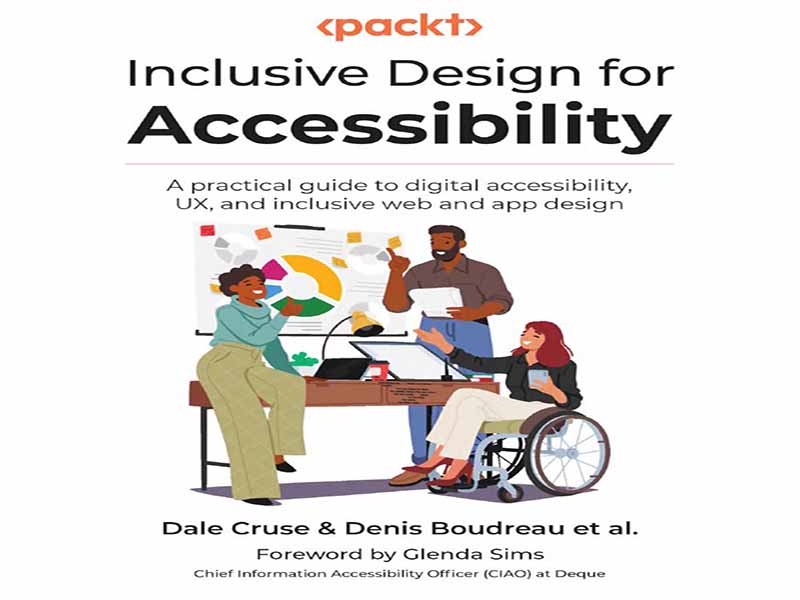- عنوان کتاب: Inclusive Design for Accessibility -A practical guide to digital accessibility, UX, and inclusive web and app design
- نویسنده: Dale Cruse & Denis Boudreau
- حوزه: طراحی UX
- سال انتشار: 2025
- تعداد صفحه: 322
- زبان اصلی: انگلیسی
- نوع فایل: pdf
- حجم فایل: 2.12 مگابایت
در دنیایی که به طور فزایندهای دیجیتالی میشود، توانایی دسترسی به اطلاعات، خدمات و فرصتهای آنلاین یک کالای لوکس نیست – بلکه یک حق انسانی است. با این حال، برای میلیونها فرد دارای معلولیت، تجربیات دیجیتال روزمره هنوز موانعی را ایجاد میکنند که مانع از مشارکت کامل میشود. چه یک برنامه تلفن همراه باشد که نمیتوان با صفحهخوان پیمایش کرد، چه وبسایتی که محتوای کلیدی را پشت ماژولهای غیرقابل دسترس پنهان میکند، یا یک ابزار هوش مصنوعی که صدا یا قصد کاربر را اشتباه تفسیر میکند، محرومیت دیجیتال همچنان یک مشکل مداوم و قابل حل است. طراحی فراگیر برای دسترسیپذیری یک راهنمای عملی برای هر کسی است که میخواهد این شکاف را پر کند – طراحان، توسعهدهندگان، تولیدکنندگان محتوا، آزمایشکنندگان QA و رهبران سازمانی. این کتاب صداهایی را از سراسر جامعه دسترسیپذیری گرد هم میآورد تا یک نقشه راه جامع برای ساخت تجربیات دیجیتال فراگیر در اختیار شما قرار دهد. این کتاب با آشنایی شما با اصول طراحی فراگیر و نیازهای متنوع کاربران واقعی آغاز میشود. از آنجا، جزئیات پیادهسازی را بررسی میکند: نحوه طراحی رابطهای کاربری قابل دسترس، نوشتن محتوای فراگیر، ساخت وبسایتها و برنامههای تلفن همراه قابل دسترس و آزمایش با ابزارهای خودکار و بینش انسانی. با تکامل فناوری، رویکرد ما نیز باید تغییر کند. به همین دلیل است که ما همچنین دسترسیپذیری را در فضاهای نوظهور مانند واقعیت مجازی، واقعیت افزوده و هوش مصنوعی بررسی میکنیم – و به استراتژیهای سازمانی مورد نیاز برای مقیاسبندی پایدار این تلاشها نگاهی میاندازیم. در سراسر کتاب، با ابزارها و فناوریهای دنیای واقعی – از صفحهخوانهایی مانند VoiceOver و NVDA گرفته تا چارچوبهای توسعه مانند SwiftUI، Compose و React Native – مواجه خواهید شد. اما مهمتر از آن، شما یک دیدگاه انسانمحور در مورد دسترسیپذیری به دست خواهید آورد: دیدگاهی که شمول را نه به عنوان یک چک لیست، بلکه به عنوان یک عمل خلاقانه، اخلاقی و حیاتی برای کسب و کار میبیند. چه تازه کار باشید و چه به دنبال ارتقاء بلوغ دسترسیپذیری سازمان خود، این کتاب به شما کمک میکند تا با همدلی طراحی کنید، با هدف بسازید و محصولات دیجیتالی ایجاد کنید که برای همه مفید باشد. در فصل 5، طراحی رابطهای کاربری قابل دسترس: طراحی بصری و تعاملی، ناندیتا گوپتا به بررسی چگونگی ساخت رابطهایی میپردازد که در ابعاد بصری، شناختی و مرتبط با ورودی فراگیر باشند. این فصل راهنماییهای عملی در مورد استفاده مسئولانه از رنگ، پشتیبانی از دسترسی شناختی، فعال کردن روشهای ورودی چندگانه و مقیاسبندی سیستمهای طراحی قابل دسترس ارائه میدهد و شما را قادر میسازد تا تجربیات دیجیتالی ایجاد کنید که نه تنها قابل استفاده، بلکه برای همه عادلانه باشد. در فصل 6، ایجاد محتوای قابل دسترس: نوشتن، تصاویر و چندرسانهای، جنیفر چادویک به تولیدکنندگان محتوا قدرت میدهد تا با استفاده از زبان ساده، قالببندی قابل دسترس و قالبهای محتوای جایگزین، به طور فراگیر ارتباط برقرار کنند. این فصل راهنماییهای عملی برای نوشتن متن واضح، برچسبگذاری عناصر تعاملی، توصیف تصاویر و چندرسانهای ارائه میدهد و با یک تمرین عملی برای کمک به تولیدکنندگان در ارزیابی و بهبود دسترسی در انواع محتوا به پایان میرسد. در فصل 7، توسعه وبسایتهای قابل دسترس: HTML، CSS و بهترین شیوههای ARIA، کریستال اسکات توسعهدهندگان را به مهارتهای بنیادی برای ساخت وبسایتهای فراگیر و قابل دسترس مجهز میکند. این فصل شامل HTML معنایی، سبکبندی CSS قابل دسترس، استفاده صحیح از ویژگیهای ARIA و استراتژیهای آزمایش است – که یک طرز فکر دسترسی-محور را تشویق میکند که شمول را در هر تصمیم کدنویسی ادغام میکند. در فصل ۸، «دسترسیپذیری موبایل: طراحی برای رابطهای لمسی و صوتی»، کریس مکمیکینگ چالشها و فرصتهای منحصر به فرد ساخت برنامههای کاربردی موبایل قابل دسترس را بررسی میکند. این فصل راهنماییهای عملی برای بهینهسازی اهداف لمسی، پشتیبانی از روشهای ورودی متنوع، طراحی برای تعامل صوتی و تضمین طرحبندیهای واکنشگرا ارائه میدهد – که تیمها را قادر میسازد تا تجربیات فراگیر موبایل را در سراسر پلتفرمها و دستگاهها ارائه دهند. در فصل ۹، «دسترسیپذیری در فناوریهای نوظهور: واقعیت مجازی، واقعیت افزوده و هوش مصنوعی»، دکتر کیت نیوتن چگونگی طراحی تجربیات فراگیر در سیستمهای همهجانبه و هوشمند را بررسی میکند. این فصل استراتژیهای عملی برای تطبیق واقعیت مجازی و افزوده برای کاربران با نیازهای متنوع ارائه میدهد و برجسته میکند که چگونه هوش مصنوعی میتواند بسته به نحوه پیادهسازی، هم دسترسیپذیری را بهبود بخشد و هم پیچیده کند. در فصل ۱۰، «مبانی الگوهای سیستم طراحی قابل دسترس»، چارلی تریپلت چارچوبی جامع برای ایجاد دسترسیپذیری در سیستمهای طراحی از پایه ارائه میدهد. این فصل بر شروع با نیازهای رایج کاربر – مانند کمبینایی، درک رنگ و دسترسیپذیری شناختی – قبل از لایهبندی در پشتیبانی از فناوری کمکی پیچیدهتر تأکید میکند و تیمها را برای ایجاد سیستمهای فراگیر و مقیاسپذیر که به طور پیشفرض موانع را کاهش میدهند، راهنمایی میکند. در فصل ۱۱، ابزارها و تکنیکهایی برای ارزیابی و اولویتبندی دسترسی، کای وانگ، CPACC، CHES®، شما را در مراحل عملی آزمایش دسترسیپذیری برای وبسایتها و برنامههای تلفن همراه راهنمایی میکند. این فصل نحوه ترکیب ابزارهای خودکار با ممیزیهای دستی، اولویتبندی و اصلاح مشکلات و گنجاندن دسترسیپذیری در گردشهای کاری توسعه را پوشش میدهد…
In an increasingly digital world, the ability to access information, services, and opportunities online is not a luxury – it’s a human right. Yet, for millions of people with disabilities, everyday digital experiences still present barriers that prevent full participation. Whether it’s a mobile app that can’t be navigated with a screen reader, a website that hides key content behind inaccessible modals, or an AI tool that misinterprets a user’s voice or intent, digital exclusion remains a persistent and solvable problem. Inclusive Design for Accessibility is a practical guide for anyone who wants to close that gap – designers, developers, content creators, QA testers, and organizational leaders alike. This book brings together voices from across the accessibility community to provide you with a comprehensive roadmap for building inclusive digital experiences. It begins by grounding you in the principles of inclusive design and the diverse needs of real users. From there, it explores the nuts and bolts of implementation: how to design accessible user interfaces, write inclusive content, build accessible websites and mobile apps, and test with both automated tools and human insight. As technology evolves, so must our approach. That’s why we also examine accessibility in emerging spaces such as VR, AR, and AI – and look at the organizational strategies needed to scale these efforts sustainably. Throughout the book, you will encounter real-world tools and technologies – from screen readers such as VoiceOver and NVDA to development frameworks such as SwiftUI, Compose, and React Native. But more importantly, you’ll gain a human-centered lens on accessibility: one that views inclusion not as a checklist, but as a creative, ethical, and business-critical practice. Whether you’re just starting out or looking to level up your organization’s accessibility maturity, this book will help you design with empathy, build with intention, and create digital products that work for everyone. In Chapter 5, Designing Accessible User Interfaces: Visual and Interaction Design, Nandita Gupta explores how to build interfaces that are inclusive across visual, cognitive, and input-related dimensions. The chapter provides actionable guidance on using color responsibly, supporting cognitive accessibility, enabling multiple input methods, and scaling accessible design systems, empowering you to create digital experiences that are not only usable but equitable for all. In Chapter 6, Creating Accessible Content: Writing, Images, and Multimedia, Jennifer Chadwick empowers content creators to communicate inclusively by using plain language, accessible formatting, and alternative content formats. The chapter offers practical guidance for writing clear text, labeling interactive elements, describing images and multimedia, and concludes with a hands-on walk-through exercise to help creators evaluate and improve accessibility across content types. In Chapter 7, Developing Accessible Websites: HTML, CSS, and ARIA Best Practices, Crystal Scott equips developers with foundational skills to build inclusive, accessible websites. The chapter covers semantic HTML, accessible CSS styling, proper use of ARIA attributes, and testing strategies – encouraging an accessibility-first mindset that integrates inclusion into every coding decision. In Chapter 8, Mobile Accessibility: Designing for Touch and Voice Interfaces, Chris McMeeking explores the unique challenges and opportunities of building accessible mobile applications. The chapter offers practical guidance for optimizing touch targets, supporting diverse input methods, designing for voice interaction, and ensuring responsive layouts – empowering teams to deliver inclusive mobile experiences across platforms and devices. In Chapter 9, Accessibility in Emerging Technologies: VR, AR, and AI, Dr. Keith Newton explores how to design inclusive experiences in immersive and intelligent systems. The chapter offers practical strategies for adapting virtual and augmented reality for users with diverse needs and highlights how AI can both enhance and complicate accessibility, depending on how it’s implemented. In Chapter 10, Foundations of Accessible Design System Patterns, Charlie Triplett lays out a comprehensive framework for building accessibility into design systems from the ground up. The chapter emphasizes starting with common user needs – such as low vision, color perception, and cognitive accessibility – before layering in more complex assistive technology support, guiding teams to create inclusive, scalable systems that reduce barriers by default. In Chapter 11, Tools and Techniques for Accessible Evaluation and Prioritization, Kai Wong, CPACC, CHES®, guides you through the practical steps of accessibility testing for websites and mobile apps. The chapter covers how to combine automated tools with manual audits, prioritize and remediate issues, and embed accessibility into development workflows – helping teams build more inclusive digital products from the ground up. In Chapter 12, Building an Inclusive Design Culture: Strategies for Organization, Denis Boudreau, CPWA, shows how to embed accessibility into an organization’s daily operations, culture, and mindset. The chapter outlines strategies for cultivating empathy, integrating accessibility into workflows, measuring progress, and sustaining continuous learning – empowering teams to move from compliance to a meaningful, people-centered practice of inclusive design.
این کتاب را میتوانید از لینک زیر بصورت رایگان دانلود کنید:
Download: Inclusive Design for Accessibility




































نظرات کاربران